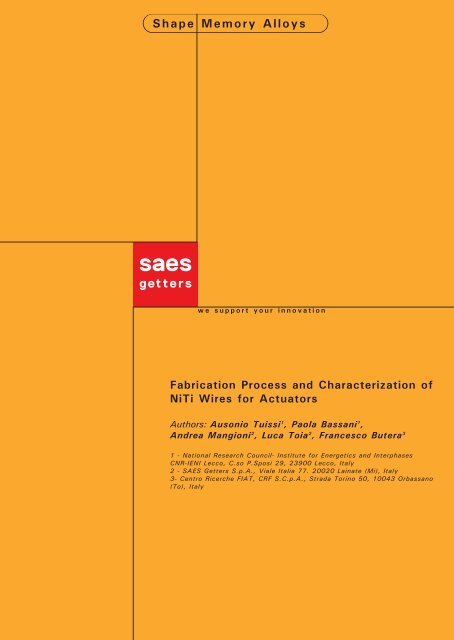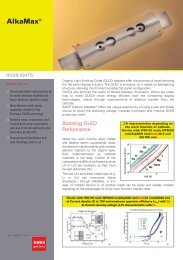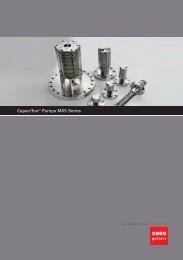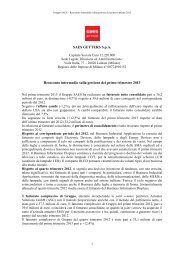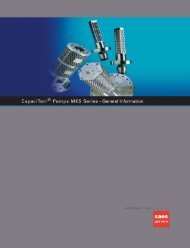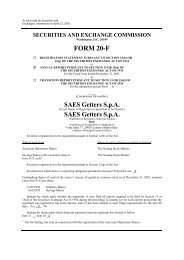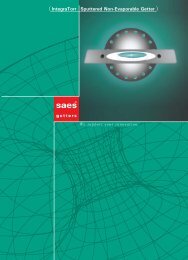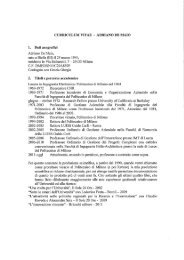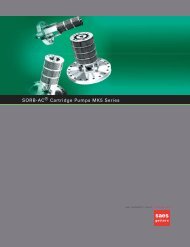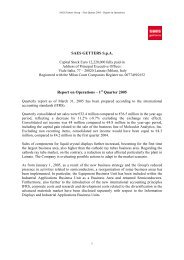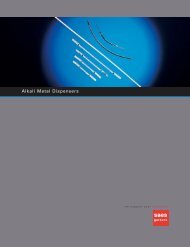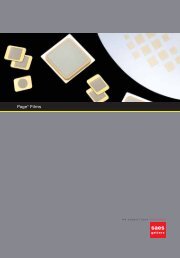Shape Memory Alloys Fabrication Process and ... - SAES Getters
Shape Memory Alloys Fabrication Process and ... - SAES Getters
Shape Memory Alloys Fabrication Process and ... - SAES Getters
Create successful ePaper yourself
Turn your PDF publications into a flip-book with our unique Google optimized e-Paper software.
<strong>Shape</strong> <strong>Memory</strong> <strong>Alloys</strong>we support your innovation<strong>Fabrication</strong> <strong>Process</strong> <strong>and</strong> Characterization ofNiTi Wires for ActuatorsAuthors: Ausonio Tuissi 1 , Paola Bassani 1 ,Andrea Mangioni 2 , Luca Toia 2 , Francesco Butera 31 - National Research Council- Institute for Energetics <strong>and</strong> InterphasesCNR-IENI Lecco, C.so P.Sposi 29, 23900 Lecco, Italy2 - <strong>SAES</strong> <strong>Getters</strong> S.p.A., Viale Italia 77. 20020 Lainate (Mi), Italy3- Centro Ricerche FIAT, CRF S.C.p.A., Strada Torino 50, 10043 Orbassano(To), Italy
AbstractA production route of NiTi wire with shape memory effect has been experimented onlaboratory equipment <strong>and</strong> transferred to pilot scale. Technological aspects of vacuuminduction melting, hot <strong>and</strong> cold working operations have been reported. The material hasbeen characterized throughout the production steps by DSC, stress-strain, fatigue <strong>and</strong>thermo-mechanical measurements.The process has been optimized for long life applications with particular focus onstabilization of functional properties over lifetime. Preliminary characterization ofactuators using shape memory alloy wires deriving from the experimented productionroute have been carried out.IntroductionNiTi is an enabling material in an increasing number of applications especially in thebiomedical field where in the last years NiTi is successfully used in engineered devicessuch as stents, orthopaedic implants <strong>and</strong> surgical tools [1]. Additional mass volumeapplications such as automotive <strong>and</strong> appliance can benefit from using SMA baseddevices. As an example over 60 electromechanical actuators can be installed in amodern vehicle, some of which could be simplified or replaced by using SMA [2]. Therelatively low transformation temperatures <strong>and</strong> the critical availability of material withtailored characteristics have been the limiting factors for implementation in large scaleapplications. In addition, very often performances of commercially available SMAmaterial can be detrimentally modified during shaping or training of the prototype SMAdevices. With this in mind integrated cooperation of alloy producers <strong>and</strong> SMA devicedesigners is key to guide the fabrication procedures of tailored semifinished products.This study investigated the technological aspects of NiTi wire manufacturing from themelting operations of a Ti rich NiTi alloy to the stabilization of the functional propertiesof the semi-finished material. The resulting wire maintained its functional characteristicsover 100.000 cycles showing at least comparable performances to the commerciallyavailable high fatigue life SMA wires. Wires of 0.4 <strong>and</strong> 0.5 mm in diameter were thensuccessfully applied in SMA actuators.Experimental MethodsMelting <strong>Process</strong>Vacuum Induction Melting (VIM) is a typical melting technique for production of NiTibased alloys. The magnetic stirring effect of the molten pool guarantees an excellentcompositional homogeneity degree of the VIM processed materials. This is particularlyappreciated for NiTi alloying because of the strong influence of the chemical compositionon the alloy phase transformation temperatures. The major disadvantage of VIM is thecontamination coming from the crucible, which is usually made of graphite.Ni49Ti51 (at.%) alloy with high martensitic transformation temperatures was melted byusing VIM plants starting from electrolytic nickel <strong>and</strong> titanium sponge (grade 1).Preliminary small ingots (5 Kg each) were prepared by using a laboratory VIM furnace(Balzers VSG 10) equipped with graphite crucible <strong>and</strong> a cylindrical metallic casting1
mould. After preliminary melts, 40 bigger NiTi ingots (20 Kg) were produced withindustrial VIM equipment (Balzers VSG 50) at Saes <strong>Getters</strong> (fig. 1). Melting <strong>and</strong> castingconditions were optimized to prevent solidification cracks <strong>and</strong> reduce shrinkage pipe intothe cast alloy.Figure 1- Industrial VIM plantFigure 2 - 5 kg ingotHot <strong>and</strong> Cold WorkingNiTi ingots were hot extruded using both direct <strong>and</strong> indirect horizontal extrusion presses.Direct extrusions were performed without protective sleeve; processing temperature(950°-1050°) <strong>and</strong> extrusion ratios (11:1 <strong>and</strong> 6:1) have been varied to optimise theprocedure.For indirect extrusion NiTi billets were canned into a protective Cu alloy sleeve <strong>and</strong>processed at temperature of about 900°C with extrusion ratios from 27:1 to 18:1. [3]After extrusion the bars were machined to remove oxides <strong>and</strong> the protective Cu alloylayer before hot rolling (900°C) down to a cross section of 50 mm 2 . The rods were hot<strong>and</strong> cold rolled <strong>and</strong> finally drawn to wire with diameters of 0.4 <strong>and</strong> 0.5 mm withintermediate fully annealing heat treatments. Several process conditions wereexperimented in order to optimize the hot <strong>and</strong> cold procedures using pilot scaleequipments with a production capability up to 150 Kg/year.TrainingThe cold worked NiTi wire does not exhibit the desired shape memory performances,which can be achieved through a series of cold work <strong>and</strong> heat treatments [4-6]. Ourtarget was to obtain a wire showing a shape memory effect with a minimum recoveredstrain re of 4 % at constant applied (bias) stress of 200MPa for at least 50.000 cycleslife. Continuous str<strong>and</strong> thermal treatments were performed in a temperature range of350-600°C under applied stress of 50-300MPa. The control of tensile load, <strong>and</strong>annealing temperature <strong>and</strong> time are crucial aspects to guarantee stabilization of the SMAfunctional properties [7]. The process was first experimented on laboratory scale Reel-To-Reel equipment <strong>and</strong> then transferred to an automatic pilot plant. A schematic view ofthe annealing apparatus is depicted in figure 3.Among the various training procedures, SMA literature teaches that the constant stressthermal cycling seems to be the most effective to promote two way shape memory2
effect[4-6]: we experimented constant stress thermal cycling as well as martensitedeformation routes. As for the hot <strong>and</strong> cold working production steps, a non continuoustraining equipment was used for experimentations at laboratory scale before transferringthe process to a continuous pilot training plant specifically designed <strong>and</strong> manufacturedfor this purpose.LOADDATA LOGGERSPEEDTemperatureFURNACEWIREPAY OFFCONTROLLERTAKE UPFigure 3 - Functional diagram of annealingequipmentCharacterizationMicrostructure of as cast <strong>and</strong> extruded materials were analysed by optical microscopy<strong>and</strong> SEM. The latter was also employed to characterize fracture surface of the cycledspecimens.The impurities content (O <strong>and</strong> C) as well as the transformation temperatures weresystematically measured in specimens cut from different longitudinal <strong>and</strong> radial positionsfrom the ingots to verify homogeneous distribution of impurities <strong>and</strong> composition.Analytical determination of oxygen <strong>and</strong> nitrogen has been carried out by gas extractionusing a LECO TC 436 instrument, while C was analysed using a LECO CS 444. AverageO <strong>and</strong> C ingots contamination were 780 ppm <strong>and</strong> 650 ppm respectively. Similar meanvalues were also measured on trained wire showing that wire preparation <strong>and</strong> trainingprocess do not significantly add contamination to the material.The transformation behaviour was examined at different material production steps byDifferential Scanning Calorimetry (DSC) using a Seiko DSC220C. All the DSC scanswere carried out upon cooling/heating at rate of 10 °C/min, according to the F 2004-00ASTM st<strong>and</strong>ard.Thermomechanical fatigue tests were performed by using cycling stations where 150mm long specimens can be vertically hanged <strong>and</strong> tensioned by a constant applied load(suspended weights). The wire is heated by Joule effect <strong>and</strong> the displacement ismeasured during heating/cooling (air) cycles between room temperature <strong>and</strong> nearly150°C under at constant tensile stress of 200 MPa.For hysteresis measurement a dedicated station similar to that reported above wasenclosed in an environmental cell, <strong>and</strong> the wire was thermally cycled at heating/coolingrate of 1 °C/min.3
Results <strong>and</strong> DiscussionThe material was melted <strong>and</strong> cast under high vacuum (P < 10 -4 mbar); typical shrinkagepipes due to solidification in a cylindrical mould were observed. Microstructures ofingots cross sections are reported in figure 5.ac1 cmb1 cm1 cmFig 5 - Microstructure of ingot cross sectionsAt the bottom of small ingots (fig. 5a) typical solidification structures can be observed: i)small grains at the outer part due to the rapid solidification; ii) a columnar grains regionobtained by an high radial temperature gradient during the solidification; iii) equiaxialgrains in the central part. The central small ingot area of fig.5b, instead, shows longcolumnar grains due to a different solidification condition. The difference in grainmorphology is likely due to the variation in feeding rate resulting from a manual castoperations, <strong>and</strong> it could causes workability properties variation during the subsequentingot hot working.For all the lengths of bigger ingots (20 Kg each) the solidification structure shows amore regular grain growth <strong>and</strong> a typical cross section is reported in figure 5c.The big ingots (20 Kg) were hot extruded <strong>and</strong>, as expected, the microstructure of theextruded rods shows a grain size adjustment due to the deformation <strong>and</strong> primaryrecrystallization phenomena relative to the hot extrusion process. Micrograph of thecross section <strong>and</strong> longitudinal sections of a hot extruded rod is depicted in fig.6: uniformequiaxial grains with mean size of about 30 m were observed in all the. Indirect <strong>and</strong>direct extrusion methods resulted in similar rod microstructures.4
Fig. 6 - Optical micrograph e of hotextruded rodCalorimetric analyses were performed on both as cast <strong>and</strong> heat treated (900°C for 1 h+ water quench) ingot samples. The DSC scans upon cooling/heating at rate of 10°C/min show typical martensitic transformation behaviours B2B19’ withtransformation heat of -33.17 J/g for the forward <strong>and</strong> 31-46 J/g for reversetransformation (see fig.8). Moreover for both as cast <strong>and</strong> solution treated specimenstaken from different zone of ingot showed Ms <strong>and</strong> Af mean values of 72°C <strong>and</strong> 107°Crespectively with a very low dispersion.Values of Austenite <strong>and</strong> Martensite temperatures from six different positions <strong>and</strong> fourdifferent ingots are summarized in the following table:Parameter Mean Value St<strong>and</strong>ard(°C)(°C)As 82.9 5.65Ap 101.4 3.90Af 107.8 5.42Ms 72.2 5.20Mp 59.0 2.90Mf 47.8 3.56deviation5
260006000N = 200N = 50.00018000Cooling2000CoolingHeat Flow [J/g]100002000-6000HeatingMf=47°Ms=70°As=85°Af=106°Heat Flow [J/g]-2000-6000Heating-14000-10000N = Number of thermomechanical cyles-22000-30000-30 -10 10 30 50 70 90 110 130Temperature [°C]Figure 7 - DSC scan of as cast material-14000-30 -10 10 30 50 70 90 110 130Temperature [°C]Figure 8 - DSC of trained wire after Nthermo-mechanical cyclesDSC curves after N=200 <strong>and</strong> N=50.000 thermo-mechanical cycles of the trained wirereported in figure 9 show the B2R <strong>and</strong> RB19’ transformation peaks upon cooling.After 50.000 the RB19’ peak is sharper than 200 cycles one <strong>and</strong> the Tp shifted onlyof 2° at higher temperatures. A single transformation signal B19’B2 is detected uponheating with a very stable behaviour as a function of thermo-mechanical cycling.These data confirm the very high stability of the wire properties over cycling.It has been observed that the RB19’ transformation is strongly affected by the trainingthermo-mechanical treatments <strong>and</strong> its parameters (behaviour, transformation heat,transformation temperatures), could give important indications for the industrial trainingprocesses.Strain (%)10-1-2re-3-4-5-60 20 40 60 80 100 120 140 160Temperature (°C)Displacement (%)0.50-0.5-1-1.5HeatingCooling-2W-2.5W-3-3.5-4-4.50 20'000 40'000 60'000 80'000 100'000 120'000 140'000Number of CyclesFigure 9 - Hysteresis measurementFigure 10 - Fatigue life testThermal cycle of 0.4 diam. mm trained wire carried out with an applied constant stressof 200 MPa is reported in figure 9. A sharp martensitic transformation occurs attemperature above 70°C with a thermal hysteretic cooling/heating behaviour of 20°C. Arecovered strain re of 5.3 % is detected.6
Tensile fatigue tests were also performed at constant stress of 200MPa. In some teststhe applied heating current was controlled to limit the strain level at 3.5%. In figure 10,the minimum <strong>and</strong> maximum position versus fatigue life shows stable behaviour with anaccumulated permanent plastic deformation of 0.3 % after 120.000 cycles. The dataare at least comparable to the ones of the best commercial stabilised productsThe fracture surfaces of the cycled wires were analyzed by scanning electronmicroscopy to clarify rupture mechanisms. The initiation point of failure is oftenassociated with the presence of defects, such as scratch, surface cracks localized at thewire surface. In our case, as expected, EDXS microanalysis carried out at the fracturesurfaces of cycled (>100.000) wires showed the presence of oxides <strong>and</strong> carbonenriched segregations at the initiation points (see fig.11) or TiC inclusions (see fig.12).Fig 11- Microfractograph of cycled >100000wire.Fig 12 - Microfractograph of cycled wireWire Testing in Automotive SMA DeviceThe stabilised wire was tested in a linear actuator, developed at Centro Ricerche FIAT,shown in the picture below:Figure 13 - SMA wire <strong>and</strong> actuator7
The SMA actuator performs both electrical <strong>and</strong> mechanical operations [8]. In normalcondition the SMA wire is activated by Joule effect <strong>and</strong> it moves retracting the terminalend of 6 mm, in misuse. By pulling the actuator, a manual operation is also available.The actuator was tested according to the st<strong>and</strong>ards for electrical actuators inautomotive field.Thanks to the SMA wire performances all tests were passed, especially a goodperformance in terms of life cycle <strong>and</strong> repeatability was achieved. In fact the newactuator can perform over 100.000 cycles in the specified temperature range (from –30°C to + 80°C) without accidental breaks.Several vehicle components can be equipped with this actuator, for instance it cansubstitute some of the mechanical bowden cable used to actuate latches, seats, ventsetc…, adding the electrical functionality without any change in components volume <strong>and</strong>mechanical structure.ConclusionsAn integrated SMA wire production process, from melting to wire training has been setup,both on lab <strong>and</strong> pilot scale. An industrial production line is currently underconstruction.Ingots <strong>and</strong> wires have been characterised on the functional <strong>and</strong> microstructural point ofview.The production process lead to the preparation of wires with state of the artperformances <strong>and</strong> stability, which make them especially suitable for the application inactuators.A special actuator, with combined electrical <strong>and</strong> mechanical functionality, has beendesigned <strong>and</strong> manufactured, based on the wire developed in this work.This actuator is currently being evaluated by a major car manufacturer.AcknowledgementsThe authors wish to thank M.Pini, G.Carcano of CNR-IENI, G. Capretti of CRF, <strong>and</strong> M.Boni of <strong>SAES</strong> <strong>Getters</strong> S.p.A. for their technical assistance.References[1] Duerig T., Pelton A., Stöckel D. Mat. Sci. And Eng. A273-275 (1999) pp 149-160[2] Butera F. in “<strong>Shape</strong> <strong>Memory</strong> <strong>Alloys</strong>: Advances in modelling <strong>and</strong> applications”, A series ofh<strong>and</strong>books Eds. Auricchio F.,Faravelli L., Magonette G., Torra V. ; CIMNE Barcelona, (2001)pp 405-426[3] Müller K.B., SMST-2000 Conference Proceedings. Eds. Russel S.M., Pelton A.R., (2001) pp43-51[4] Perkins J., Sponholz R.O. Metall. Trans. A Vol. 15A (1984) pp 313-321[5] Yiong L., Youn L., Van Humbeek ., Acta mater. Vol47, No1 pp 199-209 (1999)[6] Contardo L., Guenin G. Acta metall mater. Vol.38, No 7 (1990), pp 1267-1272[7] Pelton A.R., DiCello J., Miyazaki S., SMST-2000 Conference Proceedings Eds. Russel S.M.,Pelton A.R., (2001) pp 361-374[8] Patent US6732518
Lainate (Italy)Avezzano (Italy)Cologne (Germany)Moscow (Russia)Paris (France)Daventry (UK)Nanjing (China)Shanghai (China)Tokyo (Japan)Seoul (Korea)Jincheon-kun (Korea)SingaporeClevel<strong>and</strong> OH (USA)Colorado Springs CO (USA)San Luis Obispo CA (USA)The Saes <strong>Getters</strong> Group<strong>SAES</strong> <strong>Getters</strong> S.p.A.Group Headquarters:Viale Italia,7720020 Lainate (Milano), ItalyTel.: + 39 02 931 78 1Fax: + 39 02 931 78 320E-mail: sma@saes-group.comwe support your innovationFor worldwideSales & Service locationscheckwww.saesgetters.comISO 14001ISO 9001©2004 <strong>SAES</strong> <strong>Getters</strong>. Printed in Italy. All rights reserved.<strong>SAES</strong> <strong>Getters</strong> reserves the right to change or modify product specifications at any time without notice.


